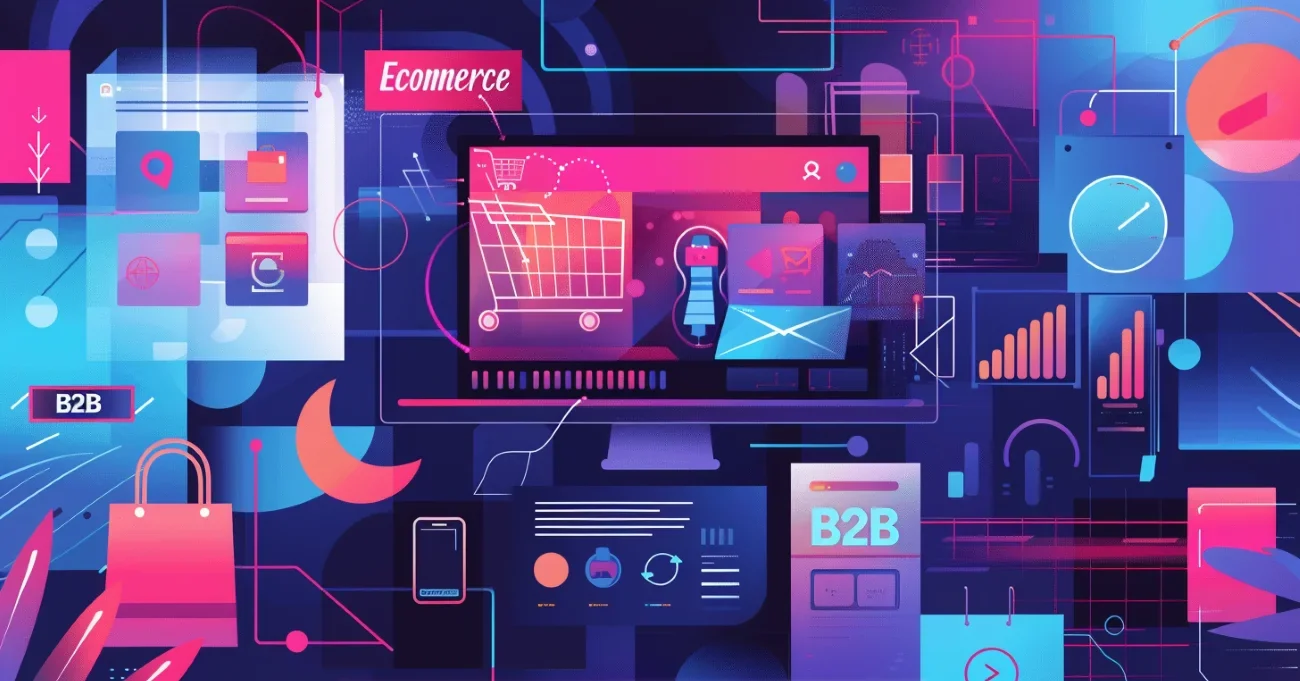B2B ecommerce trends are changing how businesses operate, sparking innovation and digital transformation. Companies are adopting cutting-edge technologies to reshape digital commerce strategies and elevate customer experiences. From AI-driven personalization to smooth omnichannel integration, these trends offer innovative solutions for businesses to help them bring their business growth and success to the next level.
Aloa, a leading software outsourcing expert, helps startups and businesses venture into B2B ecommerce. Through our expertise and guidance, we help navigate the intricate challenges of this industry, ensuring that you stay updated on the latest trends for success. By staying ahead of the curve and providing steadfast support, we ensure a rewarding journey for your business.
In this blog post, we will dive into the top B2B ecommerce statistics and trends shaping the landscape in 2024. We will also offer valuable guidance to empower businesses in navigating the dynamic world of digital commerce through insightful analysis, practical examples, and actionable insights.
Afterward, you will gain valuable insights to thrive in the dynamic space of B2B ecommerce trends. Stay ahead and utilize these advancements, leveraging innovative solutions and seizing transformative opportunities that drive excellence in your ecommerce strategies and operations.
Let’s jump in!
Top 7+ B2B Ecommerce Trends to Follow in 2024
Remaining at the forefront of B2B ecommerce trends is essential for driving success in digital commerce endeavors. In 2024, the B2B ecommerce landscape is poised for notable technological advancements. Let's explore the key trends and shifts anticipated to revolutionize B2B ecommerce this year.
Trend 1: Mobile Optimization and Responsive Design
Mobile optimization and responsive design are crucial B2B ecommerce trends reshaping online experiences. They guarantee smoother functionality and appealing visuals on smartphones and tablets, while responsive design adapts layouts across screen sizes. These trends enhance readability, maintain brand consistency, and boost search engine visibility.
During the pandemic, B2B buyers transitioned entirely to digital interactions with sellers. Now, with stabilization, 70-80% of B2B decision-makers favor remote human interactions or digital self-service options over in-person sales, as per McKinsey & Company research. This trend highlights the necessity for B2B brands to overhaul their online experiences.
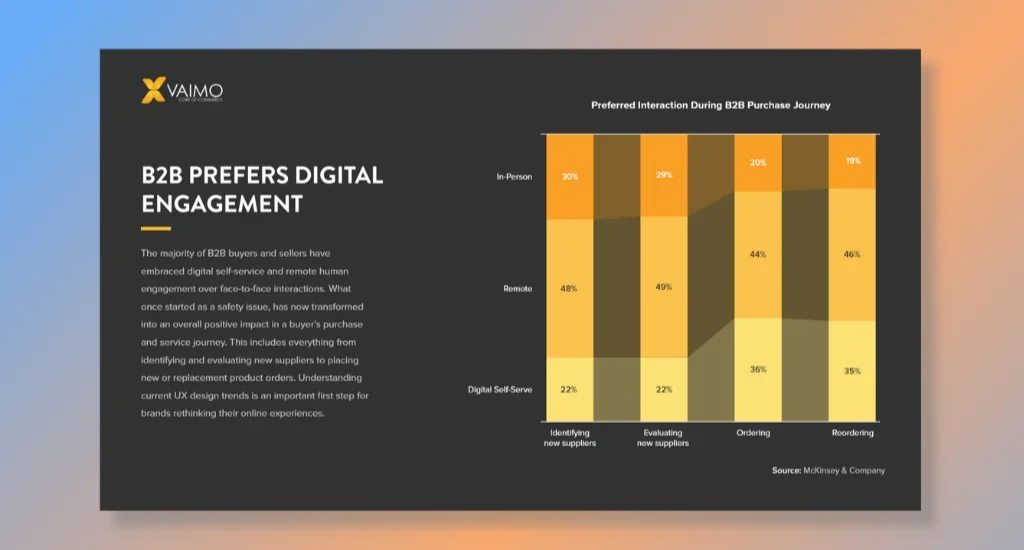
Why Mobile Optimization and Responsive Design Will Impact the Industry
Mobile optimization and responsive design are poised to significantly impact the industry due to the widespread use of smartphones and tablets for online activities. With more users accessing ecommerce sites and applications on mobile devices, ensuring seamless functionality and visual appeal across different screen sizes has become imperative.
Moreover, mobile optimization and responsive design improve user experience, boost search engine visibility, and drive conversions. As consumers increasingly expect fluid experiences across all devices, businesses prioritizing mobile optimization and responsive design will gain a competitive edge and engage their target audience better.
Trend 2: BOPIS or Click and Collect
Business-to-Business (B2B) ecommerce has witnessed a notable trend toward adopting ‘buy online, pick up in store’ (BOPIS) or click-and-collect services. This B2B ecommerce trend is driven by the increasing demand for efficiency and convenience among B2B buyers. This allows businesses to optimize procurement, enabling online ordering with store pickup.
Insider Intelligence's research report indicates that US click-and-collect sales reached $99 billion in 2023. Projections show that by 2026, they will grow to $131 billion, accounting for 9.6% of total retail ecommerce sales in the US. This trend underscores the rising popularity and convenience of the click-and-collect model for consumers and retailers alike.
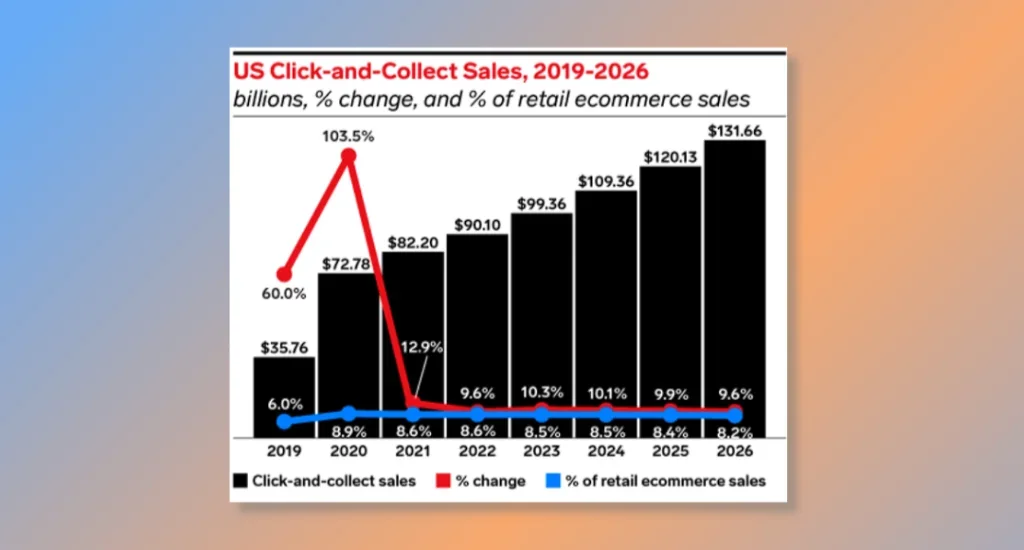
Why BOPIS or ‘Click and Collect’ Will Impact the Industry
BOPIS, or click and collect, aims to reshape the industry by providing consumers with the convenience of online shopping and in-store pickup options. This strategy improves the overall customer experience and boosts foot traffic to physical stores, potentially driving sales.
In addition, BOPIS or click-and-collect offers avenues to refine inventory management and lower fulfillment expenses for online retailers. With consumer trends favoring convenience, integrating BOPIS or click-and-collect has become crucial for retailers to remain competitive and align with shifting market trends.
Trend 3: Generative AI in eCommerce
Artificial intelligence is revolutionizing B2B ecommerce by enhancing customer experiences and streamlining operations. Through generative models like GANs (Generative Adversarial Networks) and variational autoencoders, eCommerce platforms can generate realistic product images, personalized recommendations, and even dynamic pricing strategies.
According to Dimension Market Research, the global generative AI in the eCommerce market is projected to hit USD 760.9 million by 2023, with a further expected surge to USD 2,796.4 million by 2032, showing a 15.6% CAGR. It represents a pivotal advancement in crafting personalized, efficient, and practical solutions for the global ecommerce industry.
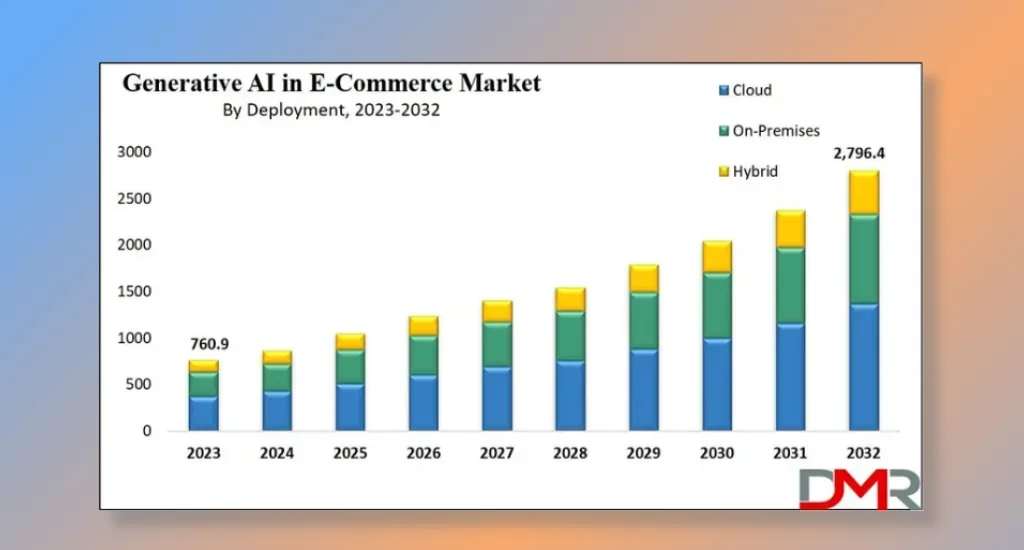
Why Generative AI in eCommerce Will Impact the Industry
Generative AI transforms the industry by improving customer experiences, optimizing operations, and boosting revenue. This trend in B2B ecommerce creates realistic product images, provides personalized recommendations, and analyzes data, enabling businesses to create engaging shopping environments and make informed decisions.
By leveraging the capabilities of generative AI, eCommerce enterprises can outpace competitors, deliver exceptional customer experiences, and tap into fresh avenues for innovation and growth within the online marketplace.
Trend 4: Buy Now, Pay Later
The “buy now, pay later” (BNPL) trend in B2B e-commerce is quickly gaining momentum, providing businesses with flexible payment methods to handle cash flow and streamline procurement processes. This innovative model resembles consumer BNPL solutions but is tailored specifically to the needs of ecommerce companies involved in purchasing and supply chain activities.
The global “buy now, pay later” market, valued at USD 753.53 billion in 2022, is projected to reach around $9,226.65 billion by 2032, with a 29% CAGR based on the Precedence Research report. This growth is driven by adopting interest-free installment plans on ecommerce websites, fueling market expansion.
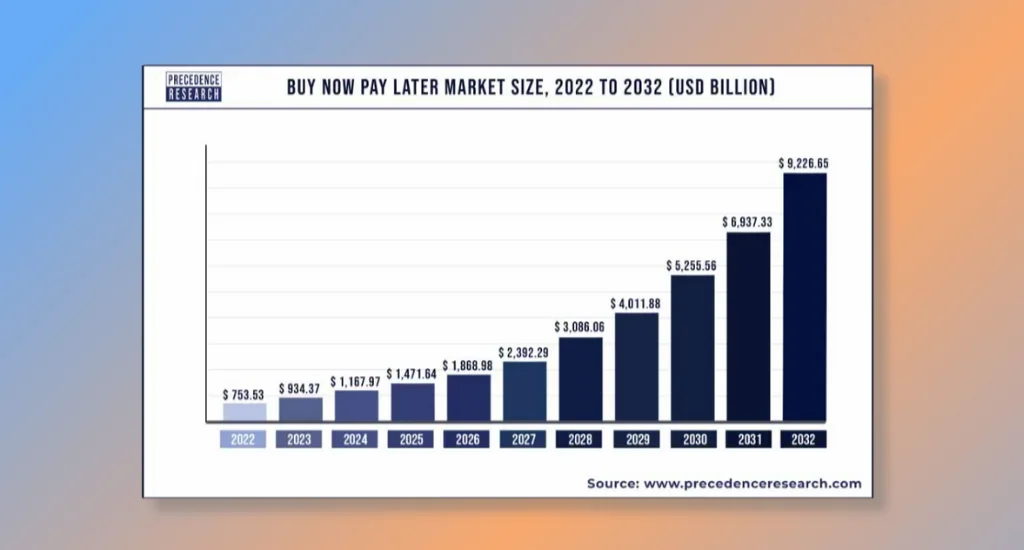
Why Buy Now, Pay Later Will Impact the Industry
The ”buy now, pay later” (BNPL) trend in B2B ecommerce is set to impact the industry significantly by offering consumers enhanced flexibility, driving higher transaction volumes, and fostering loyalty. BNPL solutions democratize access to credit, empowering a broader range of consumers to participate in online commerce.
From a business standpoint, integrating BNPL options can boost conversion rates, reduce cart abandonment, and increase average order values. As consumer behavior continues to shift towards digital-first experiences, the rise of BNPL reflects broader trends in B2B eCommerce, prompting retailers and B2B ecommerce platforms to adapt to changing preferences.
Trend 5: Real-Time Product Visualization Through Augmented Reality (AR)
Real-time product visualization with Augmented Reality (AR) is gaining traction in B2B ecommerce, revolutionizing how businesses showcase offerings. AR provides immersive experiences, driving engagement and sales by allowing customers to preview complex products before purchase.
The global augmented reality market reached USD 40.12 billion in 2022. According to the Precedence Research report, it is anticipated to soar to around USD 1,188.98 billion by 2032, with a projected CAGR of 40.34% from 2023 to 2032.
.webp)
Why Real-time Product Visualization through Augmented Reality (AR) Will Impact the Industry
Real-time product visualization via Augmented Reality (AR) revolutionizes B2B ecommerce capabilities by offering immersive shopping experiences. This trend in B2B ecommerce enables virtual interaction with products, enhancing engagement, boosting confidence in purchases, and reducing returns.
Businesses adopting AR technology differentiate themselves by offering unique, memorable shopping experiences. AR's potential to streamline sales processes and drive higher conversion rates reshapes the industry, meeting the demand for personalized, convenient shopping solutions.
Trend 6: Software as a Service (SaaS) Integration
The adoption of Software as a Service (SaaS) solutions is a growing trend in B2B ecommerce. Companies leverage SaaS platforms to streamline operations, boost efficiency, and enhance customer experiences. Expect ongoing innovation and tailored SaaS integration solutions as this trend evolves to meet the unique needs of B2B ecommerce.
According to Statista, the software as a service (SaaS) market was valued at around 197 billion U.S. dollars in 2023, with a projected increase to 232 billion U.S. dollars by 2024. SaaS applications operate in the cloud and are accessible through desktop and mobile applications and web interfaces.
%2520Integration.webp)
Why Software as a Service (SaaS) Integration Will Impact the Industry
Software as a Service (SaaS) integration is set to revolutionize the B2B ecommerce industry by optimizing operations, increasing efficiency, and elevating customer satisfaction. With businesses adopting multiple SaaS solutions like CRM, ERP, and inventory management, seamless integration between these platforms and ecommerce systems is essential.
Additionally, integration enables instantaneous data synchronization, enhancing inventory management, more personalized customer experience, and predictive analytics. This B2B e-commerce trend streamlines workflows, minimizes manual errors, and ultimately enhances productivity and competitiveness in the B2B ecommerce domain.
Trend 7: Multi-Channel Customer Support
Multi-channel customer support is crucial in B2B ecommerce, enabling businesses to offer seamless assistance across email, phone, live chat, and social media platforms. Embracing this approach enhances accessibility, personalizes interactions, improves efficiency, and continually utilizes data insights to refine support strategies.
According to Salesforce’s report, 71% of customers prefer varied channels, including email (93%), mobile apps (76%), and online chat (72%), for support inquiries. B2B ecommerce businesses can embrace an omnichannel strategy to ensure a seamless and consistent customer experience across various platforms and devices.
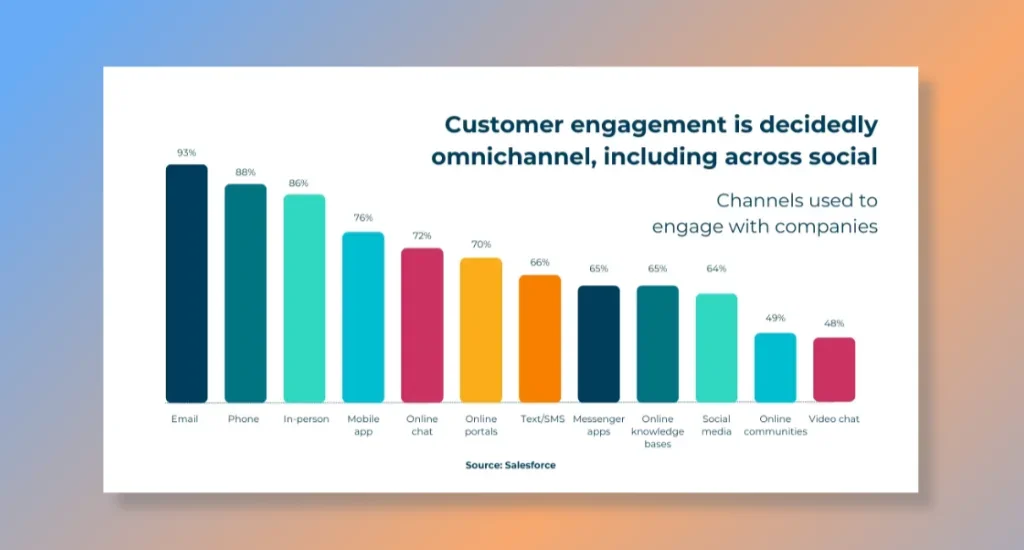
Why Multi-channel Customer Support Will Impact the Industry
Multi-channel customer support is poised to impact the B2B e-commerce industry significantly. By offering support across various digital channels such as email, phone, live chat, and social media, businesses can enhance accessibility and provide personalized assistance to their clients.
In addition, this approach improves efficiency and enables ecommerce companies to leverage valuable data insights to refine their support strategies continually. As B2B ecommerce continues to evolve, embracing multi-channel customer support will be essential for businesses to stay competitive and effectively meet their customers' changing needs.
Trend 8: The Rise of Third-Party B2B Marketplaces
Third-party marketplaces offer various products and facilitate seamless transactions. The convenience and accessibility of these platforms have improved B2B sales while aligning with evolving customer expectations. As online marketplaces continue to thrive, businesses leverage this trend to tap into new customer bases and drive their growth to the next level.
According to the Ascential Retail Insight research report, third-party sales via marketplaces are expected to become a globally predominant and swiftest-growing retail platform by 2027. These sales are projected to contribute over $1.3 trillion in additional revenue, constituting 38% of global retail sales growth
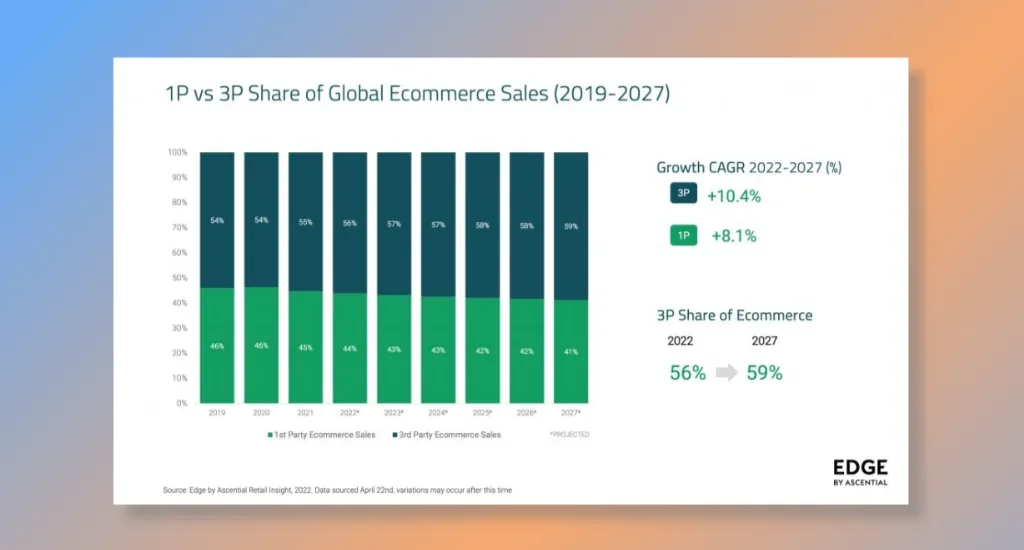
Why The Rise of Third-Party B2B Marketplaces Will Impact the Industry
Third-party B2B marketplaces are poised to revolutionize the industry by offering unprecedented convenience and efficiency. These platforms serve as centralized hubs where businesses can easily connect, browse products, and transact with suppliers and buyers.
Moreover, these marketplaces facilitate transparency and trust through standardized protocols and user reviews, mitigating the risks associated with traditional B2B transactions. With simplified procurement processes and enhanced visibility into market dynamics, businesses can make more informed decisions and capitalize on emerging opportunities.
How to Stay Ahead of the Curve in Trends in B2B Ecommerce
To effectively leverage the latest trends in B2B e-commerce, it's crucial to understand emerging technologies and strategies with a forward-thinking mindset. By implementing these strategies, you can position your B2B e-commerce business for sustained growth and success. Here are key tips to help you stay ahead and succeed in B2B e-commerce:

Conduct a SWOT Analysis
Conducting a SWOT analysis for your B2B ecommerce business focuses on identifying the strengths, weaknesses, opportunities, and threats. By recognizing and leveraging strengths, you can propel your business growth. Addressing weaknesses can help in preventing potential issues from escalating.
Seizing opportunities fosters diversification and expansion while mitigating threats avoids adverse effects. This analysis provides a strategic understanding of your ecommerce landscape for informed decision-making, ensuring sustained growth and success. When performing a SWOT analysis to evaluate B2B ecommerce, some factors need to be considered, such as:
- Market Trends: Understanding current trends in the B2B ecommerce sector helps identify opportunities and threats, allowing for timely adjustments to business strategies.
- Customer Demands and Preferences: Analyzing customer needs, preferences, and behaviors allows businesses to tailor products and services to enhance customer engagement. It is also imperative to optimize ecommerce capabilities specifically for mobile use, ensuring seamless functionality and user experience.
- Competitive Landscape: Assessing competitors' strengths and weaknesses provides insights into market positioning and potential areas for differentiation.
- Technological Advancements: Embracing innovative technologies, ecommerce tools, and platforms enhances operational efficiency, improves customer experiences, and facilitates market expansion.
- Regulatory Compliance: Adhering to industry regulations and compliance standards minimizes legal risks and fosters trust among customers and business partners.
- Supply Chain Dynamics: Evaluating the efficiency and reliability of the supply chain ensures timely delivery of products and services, thereby enhancing customer satisfaction and loyalty. This is why the support of a 3PL Company is much more effective. It will help companies optimize their supply chain and logistics operations.
- Financial Stability: Assessing the financial health of the business, including cash flow, profitability, and liquidity, helps in making informed decisions regarding investment, expansion, and risk management.
- Strategic Partnerships: Collaborating with strategic partners and suppliers strengthens the value proposition, expands market reach, and fosters innovation and growth opportunities.
Stay Updated with Market Research
Staying ahead in B2B ecommerce hinges on staying abreast of B2B ecommerce trends and understanding customer expectations. Consistently monitoring customer behavior and preferences enables businesses to adjust their strategies dynamically. It's imperative to grasp emerging technologies and their potential impact on the industry.
Furthermore, leveraging data analytics to monitor online sales and customer behavior is pivotal for informed decision-making and future growth strategies. For businesses looking to gather this data at scale, specialized services can help with large-scale ecommerce data collection to track prices, product assortments, and trends across competitor sites and marketplaces. Remaining current with market research empowers businesses to make well-founded decisions, anticipate market demands, and stay competitive within the constantly evolving B2B ecommerce domain.
Embrace Technological Innovations
B2B ecommerce swiftly incorporates cutting-edge technologies like AI, machine learning, blockchain, and Internet of Things to enhance operational efficiency. Chatbots and virtual assistants are also utilized to enrich customer experience and bolster sales.
In addition, adopting cloud computing and edge computing ensures safe data storage and processing, while augmented reality and 3D printing revolutionize product visualization and customization. Staying competitive necessitates B2B ecommerce entities' consistent adaptation to these technological advancements.
Focus on Personalization and Customer Experience
In B2B ecommerce, prioritizing personalization and enhancing customer experience is paramount for differentiation. Customized product recommendations and smooth shopping experience are no longer optional but rather anticipated by B2B purchasers, underscoring the importance of customer data analytics and omnichannel approaches.
Moreover, adapting to evolving buyer preferences and the increasing mobile commerce volume is crucial for sustained success, ensuring ongoing competitiveness and alignment with customer requirements. Embracing these strategies will foster heightened customer satisfaction and promote sustainable business expansion.
Expand Omnichannel Presence
Expanding social commerce across web, mobile, and social media channels can profoundly enrich customer experience and boost sales for B2B ecommerce platforms. Adopting an omnichannel sales strategy empowers customers to effortlessly transition between channels, offering a unified and personalized journey.
By harnessing data from diverse channels, B2B firms can customize interactions and efficiently engage with prospective clients. Nonetheless, realizing this expansion demands significant technological investments and establishing a specialized team to oversee and refine the intricate processes. In many cases, B2B firms partner with a sales outsourcing agency to help plan and execute their marketing campaigns while relying on an outsourced software company to ensure the technical aspects of lead capture and conversion work seamlessly. In doing so, these firms achieve a true omnichannel customer experience.
Invest in Supply Chain Optimization
Investing in supply chain optimization through technology and supplier collaboration expedites order fulfillment, reduces costs, and boosts customer satisfaction. Partnering with a high-margin print-on-demand tech accessory provider like Podbase can help you streamline production and fulfillment while keeping costs predictable. Real-time data visibility identifies and addresses bottlenecks, refining decision-making for enhanced efficiency.
This strategic approach not only cultivates business expansion but also nurtures strategic partnerships and alliances, ensuring the timely availability of the right products to meet diverse needs and propel your business forward. Several key factors should be considered when investing in supply chain optimization, including:
- Technology Integration: Evaluate available supply chain technologies for their ability to streamline processes, offer real-time data visibility, and improve decision-making.
- Supplier Collaboration: Assess supplier collaboration opportunities to enhance efficiency, shorten lead times, and boost supply chain performance.
- Cost Reduction: Analyze potential cost savings through supply chain optimization by identifying inefficiencies and investing in areas for long-term cost reduction.
- Order Fulfillment Speed: Consider how supply chain optimization affects order fulfillment speed. Faster processing and delivery times can enhance customer satisfaction and loyalty.
- Data Visibility: Highlight the significance of real-time data visibility in spotting and resolving supply chain bottlenecks. Access to current and precise data facilitates proactive decision-making and reduces risks linked with disruptions.
- Business Expansion: Acknowledge the importance of supply chain optimization in supporting business expansion. An optimized supply chain ensures the timely availability of products and services to meet growing demand, facilitating growth initiatives.
- Customer Satisfaction: Prioritize customer satisfaction as a critical result of supply chain optimization efforts. Businesses can improve customer experience and foster long-term relationships by delivering products swiftly and reliably.
Foster Strategic Partnerships and Alliances
In today's competitive landscape, fostering strategic partnerships and alliances is crucial for B2B companies. Developing such alliances can lead to new customers and market opportunities, increased revenue, and the ability to leverage complementary strengths and resources. Collaborating with partners also enhances customer experiences and satisfaction.
Furthermore, choosing partners with similar values and goals ensures a cohesive approach toward mutual success. Communication and collaboration are pivotal in maintaining successful partnerships and sustaining business growth and prosperity.
Key Takeaway
Embracing B2B ecommerce trends encourages businesses to integrate emerging technologies, optimize sales strategies, streamline supply chain management, and enhance customer relationships through data analytics. As businesses embrace the digital shift, they position themselves to thrive in an interconnected global economy.
Leveraging B2B ecommerce innovations requires collaboration among sales, marketing, and technology teams. This effort reshapes sales approaches, enhances customer interactions, and fuels business expansion. Such collaboration fosters agility and adaptability, ensuring sustained competitiveness in the market.
Seize this opportunity to subscribe to our email list through the Aloa blog page to receive regular updates on the latest insights and trends in the ecommerce industry. We'll deliver valuable content that keeps you informed and ahead of the curve, empowering you to leverage the latest trends for increased profitability and business success!

